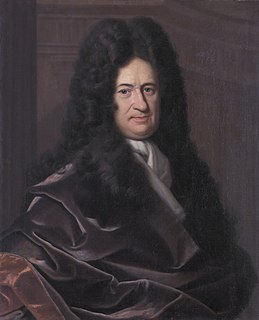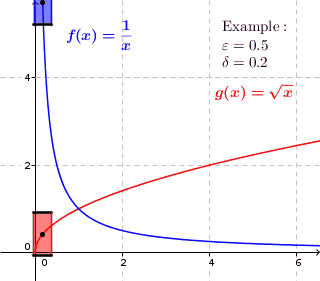
In mathematics, a Cauchy sequence, named after Augustin-Louis Cauchy, is a sequence whose elements become arbitrarily close to each other as the sequence progresses. More precisely, given any small positive distance, all but a finite number of elements of the sequence are less than that given distance from each other.
In mathematics, a continuous function is a function such that a continuous variation of the argument induces a continuous variation of the value of the function. This means that there are no abrupt changes in value, known as discontinuities. More precisely, a function is continuous if arbitrarily small changes in its value can be assured by restricting to sufficiently small changes of its argument. A discontinuous function is a function that is not continuous. Up until the 19th century, mathematicians largely relied on intuitive notions of continuity, and considered only continuous functions. The epsilon–delta definition of a limit was introduced to formalize the definition of continuity.

In mathematical analysis, the intermediate value theorem states that if f is a continuous function whose domain contains the interval [a, b], then it takes on any given value between f(a) and f(b) at some point within the interval.

The history of calculus is fraught with philosophical debates about the meaning and logical validity of fluxions or infinitesimal numbers. The standard way to resolve these debates is to define the operations of calculus using epsilon–delta procedures rather than infinitesimals. Nonstandard analysis instead reformulates the calculus using a logically rigorous notion of infinitesimal numbers.

In mathematics, real analysis is the branch of mathematical analysis that studies the behavior of real numbers, sequences and series of real numbers, and real functions. Some particular properties of real-valued sequences and functions that real analysis studies include convergence, limits, continuity, smoothness, differentiability and integrability.

In mathematics, a function f is uniformly continuous if, roughly speaking, it is possible to guarantee that f(x) and f(y) be as close to each other as we please by requiring only that x and y be sufficiently close to each other; unlike ordinary continuity, where the maximum distance between f(x) and f(y) may depend on x and y themselves.
In the mathematical field of analysis, uniform convergence is a mode of convergence of functions stronger than pointwise convergence. A sequence of functions converges uniformly to a limiting function on a set if, given any arbitrarily small positive number , a number can be found such that each of the functions differ from by no more than at every pointin. Described in an informal way, if converges to uniformly, then the rate at which approaches is "uniform" throughout its domain in the following sense: in order to guarantee that falls within a certain distance of , we do not need to know the value of in question — there can be found a single value of independent of , such that choosing will ensure that is within of for all . In contrast, pointwise convergence of to merely guarantees that for any given in advance, we can find so that, for that particular, falls within of whenever .

In mathematics, the system of hyperreal numbers is a way of treating infinite and infinitesimal quantities. The hyperreals, or nonstandard reals, *R, are an extension of the real numbers R that contains numbers greater than anything of the form

In mathematics, an infinitesimal or infinitesimal number is a quantity that is closer to zero than any standard real number, but that is not zero. The word infinitesimal comes from a 17th-century Modern Latin coinage infinitesimus, which originally referred to the "infinity-th" item in a sequence.
In mathematics, the limit of a function is a fundamental concept in calculus and analysis concerning the behavior of that function near a particular input.
In nonstandard analysis, a branch of mathematics, overspill is a widely used proof technique. It is based on the fact that the set of standard natural numbers N is not an internal subset of the internal set *N of hypernatural numbers.
In model theory, a transfer principle states that all statements of some language that are true for some structure are true for another structure. One of the first examples was the Lefschetz principle, which states that any sentence in the first-order language of fields that is true for the complex numbers is also true for any algebraically closed field of characteristic 0.
In mathematics, nonstandard calculus is the modern application of infinitesimals, in the sense of nonstandard analysis, to infinitesimal calculus. It provides a rigorous justification for some arguments in calculus that were previously considered merely heuristic.
The term differential is used in calculus to refer to an infinitesimal change in some varying quantity. For example, if x is a variable, then a change in the value of x is often denoted Δx. The differential dx represents an infinitely small change in the variable x. The idea of an infinitely small or infinitely slow change is, intuitively, extremely useful, and there are a number of ways to make the notion mathematically precise.
In mathematics, a negligible function is a function :\mathbb {N} \to \mathbb {R} } such that for every positive integer c there exists an integer Nc such that for all x > Nc,
In nonstandard analysis, the standard part function is a function from the limited (finite) hyperreal numbers to the real numbers. Briefly, the standard part function "rounds off" a finite hyperreal to the nearest real. It associates to every such hyperreal , the unique real infinitely close to it, i.e. is infinitesimal. As such, it is a mathematical implementation of the historical concept of adequality introduced by Pierre de Fermat, as well as Leibniz's Transcendental law of homogeneity.
In nonstandard analysis, a hyperintegern is a hyperreal number that is equal to its own integer part. A hyperinteger may be either finite or infinite. A finite hyperinteger is an ordinary integer. An example of an infinite hyperinteger is given by the class of the sequence (1, 2, 3, ...) in the ultrapower construction of the hyperreals.
Elementary Calculus: An Infinitesimal approach is a textbook by H. Jerome Keisler. The subtitle alludes to the infinitesimal numbers of the hyperreal number system of Abraham Robinson and is sometimes given as An approach using infinitesimals. The book is available freely online and is currently published by Dover.

In mathematics, a real number is a value of a continuous quantity that can represent a distance along a line. The adjective real in this context was introduced in the 17th century by René Descartes, who distinguished between real and imaginary roots of polynomials. The real numbers include all the rational numbers, such as the integer −5 and the fraction 4/3, and all the irrational numbers, such as . Included within the irrationals are the real transcendental numbers, such as π (3.14159265...). In addition to measuring distance, real numbers can be used to measure quantities such as time, mass, energy, velocity, and many more. The set of real numbers is denoted using the symbol R or and is sometimes called "the reals".























